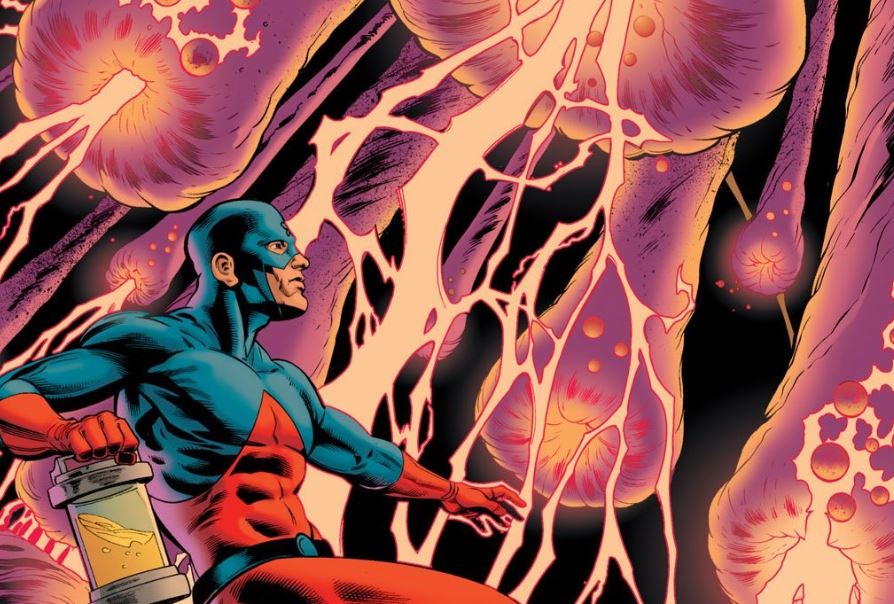The Atom can shrink. It…goes with the name, I guess.
Over the decades, there have been several “Atoms” in DC Comics’ stories. A quick rundown starts with Al Pratt in the Golden Age (who couldn’t shrink, but was short and packed an “atomic” punch), to Ray Palmer (Ivy University physicist), to Adam Cray (who died…Suicide Squad stuff), to Ryan Choi (Palmer’s graduate student, still around), to Rhonda Pineda (Atomica, who died…Justice League stuff), to an Atom in the year One Million.
Extending things out from the comics, you’ve got Brandon Routh’s Ray Palmer/Atom and Osric Chau as Brandon Choi in CW’s Arrowverse, a quick appearance by the Al Pratt version in Smallville, a handful of animated versions in the DC animated series over the years – Justice League Unlimited, Justice League (modern and classic), Batman: Brave and the Bold, Young Justice, Teen Titans Go!, as well as in the DC Comics Lego and Injustice videogames. And don’t even start with heroes who trace their roots to the Atom – Batman Beyond has Micron, and of course, the Legion of Super-Heroes has Shrinking Violet.
As a character, the Atom gets around. And his most common version is that with the identity of Dr. Ray Palmer (although Choi has been getting his fair share of screen and panel time). Despite all the character appearances, as a science teacher, it kills me that I have to introduce the character every year to my students.
Every year. Blank stares when he shows up to talk about atomic structure in my classroom materials. Kills me.
But we’re not here to talk about my hang-ups with the Atom (there are a few more). We’re here to talk about something that’s almost a trope in DC Comics – the Ray Palmer version of the Atom going into someone’s brain. Over the years, and continuities, he’s been in Batman’s brain at least twice, Superman’s brain, Jimmy Olsen’s brain, Darkseid’s brain, the Joker’s brain, his tech helped someone get into Sue Dibny’s brain, and…there are probably several more. After eight or so, I stopped hunting.
On these trips, he’s evicted microscopic alien civilizations (Batman), killed/paralyzed the brain’s owner (Superman, Sue Dibney, Darkseid), “driven” a clinically dead body (Batman), removed alien tech (Jimmy), and just…fixed things up.
As always, I’m not here to poo-poo the idea of the Atom going into someone’s brain. Nope. Look – he did it. The images are right there. It happened.
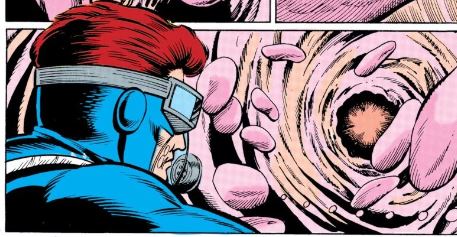
Look – I’m not about to deny any of this happened. There are pictures. Alright – illustrations, but still. (c) DC Comics
What I am here for is to use the Atom as that spark, that hook to look at the brain a little. Let’s get a feel for the larger anatomy of the brain, its defenses, and some do’s and don’ts based on the Atom’s adventures.
Let’s head in.
A Fantastic Voyage – Getting Inside the Brain
In the stories that have taken the Atom inside brains, it’s been a relatively simple process – he just shrinks small enough, and he’s inside. Oh, as he mentioned to one of the doctors who asks him about getting air in Brave and the Bold #31:
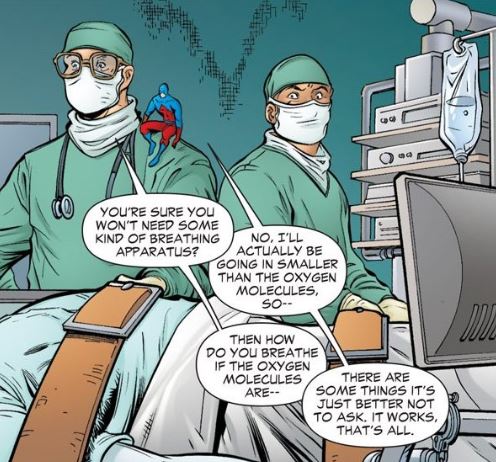
If you’re wondering how he eats and breathes, and other science facts, just repeat to yourself “It’s just a show, I should really just relax… (c) DC Comics – image, lyrics, (c) Best Brains, Inc
See? I’m not going to argue with that. Seems like a reasonable explanation to me.
Overwhelmingly, when the Atom goes into the brain, he jumps in through an ear, a nose, or an eye. Makes sense – those are literally the holes in your head and would seem to provide access to the brain, right? Let’s take a look.
Getting Into the Brain From the Outside
The brain is the most important organ in our bodies…according to the brain at least. If you’re buying what your brain is telling you about how important it is, then its protective anatomy and other systems that keep it safe shouldn’t be any big surprise. It’s got brainguards. They’re like bodyguards, except for the…never mind.
Before we jump into the brain, let’s look at what surrounds it – you’ve got the cranium (the bone layer that specifically protects the brain, while the “skull” is the cranium and the face bones), and then inside that, the meninges. The meninges are made of three layers of tissue – moving from the outside in: the dura mater, the arachnoid, and the pia mater.
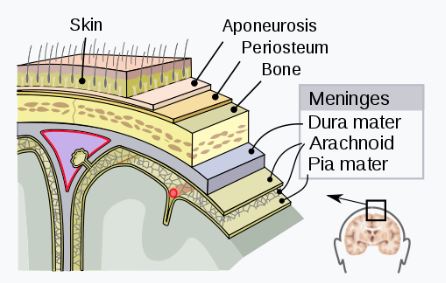
The layers of the meninges – CC, 2020
The dura mater is non-elastic, almost leathery, and whitish, and made of two layers – the periosteum on the outside and the dura on the inside, which layers over the brain and helps give it it’s larger, distinctive form of regions and compartmentalized regions. The arachnoid covers the entire brain and is separated from the dura by the subdural space. More transparent than the dura, the arachnoid contains many blood vessels. Right up against the brain is the pia mater, which covers the entire surface of the brain and follows all its folds. Separating the pia and the arachnoid is the subarachnoid space.
If you’ve ever seen a photo or video of brain surgery, the dura mater can be identified as the white layer that is cut through and folded back. It’s why, if you open a skull (carefully) you don’t see the gray, wrinkled skull right away, you see a white…bag-like thing around what has to be a brain inside it.
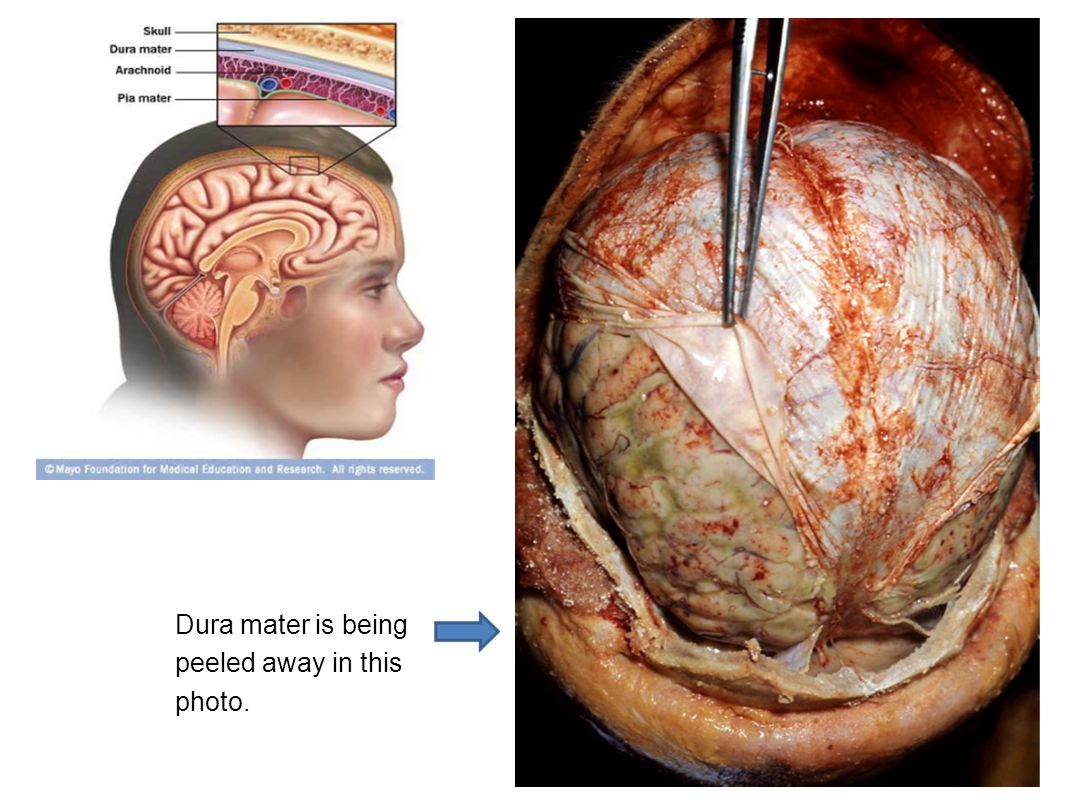
Dura mater is being peeled away in this photo.
Having a neurosurgical assist would by far be the easiest way for the Atom to get into a brain – the surgeon could open up the meninges and Ray could jump in, or be injected into the proper region he’s after. Look – I’m no brain surgeon, but this teamup of the Atom and a board-licensed neurosurgeon would be the easiest and safest way to go, hands-down.
But the Atom is a superhero, and this is comics. Easy and safe aren’t options.
Being an Ear, Eyes or Nose Guy
Taking your friendly neighborhood neurosurgery assist off the table, let’s try for going in through the other holes…what do those pathways look like?
And just to be clear – I’m just talking about passageways here, not propulsion, transportation or anything else. Whether he somehow flies, or runs along the pathway – not important right now. Getting in? That’s what we’re talking about. Pathways.
Let’s start with the Atom getting into the brain through the ear. To do that, it’s in through the outer ear, through the middle ear, through the inner ear, getting through some small bones, and then – sliding along on the vestibulocochlear nerve, the 8th cranial nerve. The nerve travels through the skull via a small (1 cm long) pathway called the auditory meatus, basically, a short tunnel through bone by which the nerve gets to the brain, proper, near the base.
[image of the ear]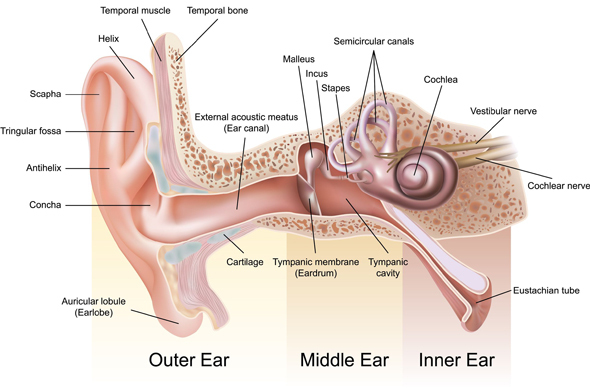
Shrinking small enough to get through the bones of the ear without damaging them would be a necessity, which means molecular scale or smaller to navigate through densely-packed bone cells. Here’s the thing though, and we’ll come back to this again – the human head is a pretty efficiently packed assortment of nerves, bones, fluids, and other tissues. There’s little room for anything pushing through in the space that’s there unless it’s really, really, virtually unnoticeably small – which is good for the Atom. Who can be unnoticeably small.
Case in point – an infection of the nerves that travel through the auditory meatus will cause an inflammatory response – swelling – taking up more room. The thing is, the auditory meatus is the passageway for the vestibulocochlear nerve, as well as the facial nerve. Inflammation there will increase the pressure on the nerves, causing them to misfire, or just stop firing. If the facial nerve’s activity slows or stops, the side of the face innervated by that nerve will sag or become paralyzed, the eye on that side will not close fully, you’ll drool out of that side of your mouth, and talking will be difficult. It’s a condition known as Bell’s Palsy, and speaking from personal experience, it’s not fun. And everyone thinks you’ve had a stroke.
There’s no room for a tiny guy in anyone’s brain. Keep that in mind – this will be a theme.
Also as an aside – the eardrum and bones of the ear are enough to stop any bug from eating its way into your brain, all urban legends and horror stories to the contrary. Although a very severe ear infection (or eye, or sinus) could, potentially, make its way to the brain via the same pathway the Atom would follow.
Going in through the eye would be similar to entering through the ear, minus having to slide through the bone. As we saw when the Atom and Green Arrow took on Darkseid in JLA #14, he could just shrink small as a photon to get through Darkseid’s force field (because light can get through it – as the Atom notes, they can see Darkseid…) and then grow up many orders of magnitudes while still being small enough to pass through Darkseid’s cornea,his pupil, his lens, his vitreous humor, his retina, and then down the optic nerve and into the brain via the optic foramen – the hole in the back of the eye socket.
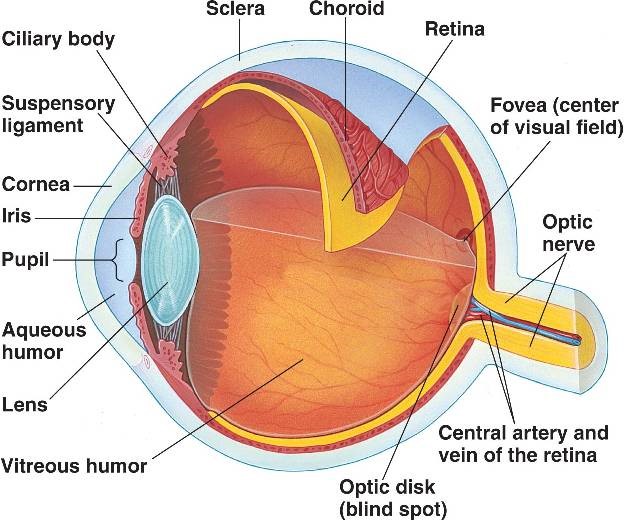
In through the eye and then the optic nerve? No bones in the way.
Getting into the brain through the nose is also a method the Atom has used on occasion, for example, when he and Superman went up Batman’s schnozz into his brain and found a small alien city there (…yeah) – there is some bone in this approach as well, though. While no one is evicting alien cities, this approach is occasionally used in certain types of brain surgery to gain access to regions on the base of the brain by removing the thin layer of bone that separates the upper portion of the nose from the brain.

This was a weird one…there was an alien civilization living in Batman’s brain. (c) DC Comics
Take a Ride on the Bloodstream!
Okay – so again, no neurosurgeon on site, but still – going in through the ear, eye or nose is going to give medical professionals the willies just in case any happen to be around. The Atom would end up tramping through the nerves to get into the brain and, while that’s a pathway for sure, you just probably don’t want anyone tramping on your nerves if at all possible.
Lucky for us – and the Atom on occasion – there is a rapid-transit system built into the body already that has stops at all stations. We call it the circulatory system.
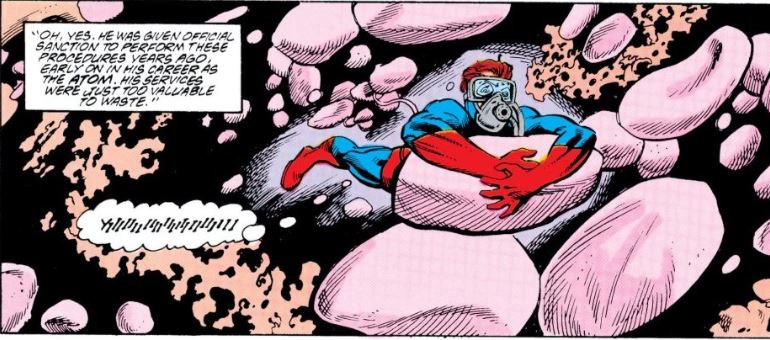
Red blood cell rodeo! (c) DC Comics
Just jump into the bloodstream and ride to the brain. You know – get in through a vein, run through the heart and then catch a ride on the right or left carotid artery into the brain, and jump out where you need to. Easy-peasy, right? I mean – aside from figuring out where to jump out…that circulatory system travels really quick, and it’s not like there are signs…or an amusement park in there to use as landmarks.
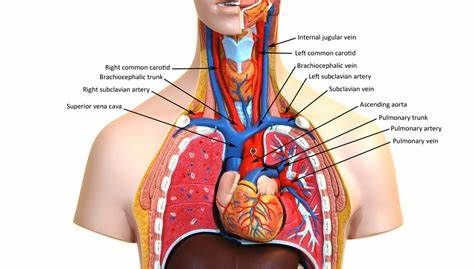
Out to the aorta and then up the right or left carotid artery. Next stop – brain!
To be fair to Ray – back in The Power of the Atom #13 (1989), writer William Messner Loebs thought about this when Ray went in to fix a subdural hematoma. The doctor on the outside shined a laser light at the approximate location of the hematoma that Ray, on the inside, zooming around on a red blood cell, could spot and know that he was in the right place. How he was able to see afterward though – that’s just another…don’t ask. I mean, it’s not like the inside of the body is brightly lit…
So – something (or someone) injected into the circulatory system will get into the brain. Cool. Actually…this approach isn’t as quick and easy as it sounds – you’ve got to overcome the blood-brain barrier. Think of it as a tight wall built inside the blood vessels in the brain, with the bricks in this wall being endothelial cells – the cells that line the walls of blood vessels. Endothelial cells are in every blood vessel, but in the brain, they’re much closer together, forming what’s called tight junctions.
Supplementing these tight junctions on the brain’s blood vessels are the “end-feet” that extend from astrocytes (one of the many types of cells in the brain) to the outside of the blood vessels, adding support to the endothelial cells.
The point of the blood-brain barrier is exactly what you think – to strictly control what comes into the brain’s extracellular space from the blood. Simply, this limits simple, mechanical passage between the blood and extracellular fluid to the smallest of substances like water, oxygen, carbon dioxide, and other lipid-soluble substances that can cross the barrier on their own. Other substances, like glucose – the brain’s exclusive energy source – need to go through a mediator – and must be actively transported from the blood into the fluid surrounding the cells in the brain. From there, the substances can interact with the neurons and cells of the brain.
There are a limited number of locations in the brain where the blood-brain barrier isn’t as tight on the vessels, though. Chief among those is near the circumventricular organ, a collection of structures near the brain’s ventricles, where the cerebrospinal fluid is produced and circulated. Also in that region is the posterior pituitary gland and the subfornical organ, both of which are involved in releasing and responding to the levels of hormones in the bloodstream. If that’s your job, it’s a good thing to have a window that opens to the bloodstream. Those windows are limited though. A blood-cerebrospinal fluid barrier is present in the choroid plexus which operates similarly to the blood-brain barrier, but with different structures that allow different substances through.
But back to the barrier – look back to what squeezes through there – chiefly water (H2O), oxygen (O2) and carbon dioxide (CO2). That’s atomic scale. To jump out into the brain from just any blood vessel would require a very small Atom. An atom-sized Atom. Or he could get out at the circumventricular organs and then backtrack to where he needed to go in the first place.
While on the surface, this virtually impenetrable barrier between the blood and the brain is great – another way the brain protects itself. Without somehow affecting or modifying the permeability of the barrier, most stuff in the blood can’t get through without an invite. Viruses? Nope. Bacteria? Double nope. Both of those potentially infectious agents are gigantic compared to water, oxygen or carbon dioxide molecules. As a result, infections in the brain and connected central nervous system are rare. Not impossible or unheard of, but rare.
The problem comes when you want to get something into the brain – not like the Atom, but like an antimicrobial drug or antibodies to fight an infection in the case of say, that rare brain infection. The brain has ways of opening up the blood-brain barrier in case of emergency, while certain conditions can cause it to be “leaky” or not as tight as it would be normally. Also, there are other methods of opening the barrier that have been shown to have some effectiveness – including microwaves, radiation, and ultrasound. If the Atom is going to the brain via the circulatory system, he’d do well to have one of these methods ready to go…or just shrink again, smaller to squeeze through and gain access to the brain.
A Word About Brain Juice
While we’re talking about being “inside” the brain, earlier I mentioned cerebrospinal fluid. Produced in the ventricles of the brain, the CSF flows in and around the brain and the spinal cord. The brain floats – literally – in the CSF, which means it won’t smoosh any of its own blood vessels toward the bottom, or whatever happens to be the “down” area of the brain. CSF also protects the brain as a shock absorber, distributes substances between the cells of the brain, and clears cellular waste products.
Its volume stays at roughly 125 – 150 mL in adults, but can be reabsorbed into cells and released relatively quickly in response to intracranial pressure…you know, if a small man showed up inside your brain, he would displace a set volume of CSF which would have to be reabsorbed, otherwise, the pressure inside the skull would increase, putting the brain in danger. The skull’s not going to give if the pressure inside it increases. The brain’s going to be squeezed, pinching off blood vessels supplying blood to regions of the brain, causing an ischemic stroke – where blood supply to a region of the brain is cut off.
The CSF is present throughout the brain, making any adventuring through it a scuba-type of situation, rather than a spelunking one. Thanks to the CSF, there are no dry spots in the brain.

The Proteus – the sub from Fantastic Voyage and it’s wet-suit clad crew. It’s all liquid inside. (c) 20th Century Fox
Is the Brain…Roomy?
That last part brings up a point about many of the Atom’s brain-bustin’ adventures. It’s often shown to resemble a cave system:
There’s often plenty of room around for the Atom to lap, spin lie low, or otherwise do his work. While there may be plenty of empty room in human brains in the DC Universe, that’s not how things are in ours. We’re a solid pack inside our skulls. Like a can of SPAM. But with blood vessels. And things that do things.

All that room! (c) DC Comics
There’s no room for activities, really. It’s all efficiently packed in there. As I mentioned earlier with this theme – if you increase the volume inside the cranium, you’ve got a serious medical condition. If a blood vessel in the dura tears and spills blood between the dura and the arachnoid layers, that’s a subdural hematoma. A rupture in a blood vessel inside the brain is an aneurysm, and is often fatal for one of two reasons – either the increase in intracranial pressure or the region of the brain the blood was headed towards is now going without and pretty quickly shuts down. Aneurysms can also happen in the dura mater, between the arachnoid and pia mater.
Infections of the brain or meninges can also cause an increase in intracranial pressure – from hydrocephalus (“water on the brain”) from a buildup of CSF, an amoebic infection, encephalitis caused by a viral pathogen, or meningitis, an infection (with an inflammatory response) of the meninges.
When intracranial pressure starts to climb, drastic measures are often taken – up to and including drilling a hole in the skull to let some of the excess CSF flow out. In extreme, usually fatal cases the brain itself will push down through the foramen magnum – the big hole in the bottom of the skull that makes it so easy to stick it on a spear tip at the edge of your village.
There’s really no extra room for a tiny man in your brain. Volume – the space taken up by any brain explorer, whether by the Atom, Fantastic Voyage’s sub, the Proteus, or anyone else – would be, well should be one of the chief concerns while visiting. Like you, brains don’t do well under pressure.
Check the video below – this is series filmed as slices were taken off of the top of the head moving down. There’s not much room at all. Oh, and the spaces you spot around 0:23 – those are the ventricles where the CSF is made and circulated.
If you search for brain images, you’ll most likely see preserved brains used in anatomy and neuroscience classes. While they may look like they have open spaces and roomy areas for potential activities – they are slightly to very dehydrated, and the brain tissue has shrunk as part of the preservation process.
Defenders of the Brain
If there’s one aspect (okay, there are lots, actually) of the Atom invading the brain that gets conveniently overlooked, it’s one that completely kills the reality of the idea…I mean, okay…”reality.” In this age of COVID and talk of antibodies and immunity, it shouldn’t come as any surprise that your brain isn’t going to be down with the idea of “the other” floating around inside it. A pathogen inside the brain is a serious threat to the brain, so you can bet it’s not going to wait around for the body’s immune system to kick in. It’s got its own security force.
Inside the brain, glial cells, in general, are responsible for identifying pathogens, with microglial cells specifically grabbing and gobbling up (phagocytozing) cellular debris after a nerve cell dies, or when chemical signals from a pathogen bind to the microglial cells and spur it into action. An increase in microglial cells and activity will lead to inflammation of the neural tissue, which in itself can weaken the blood-brain barrier. Along with the neuroinflammation, cells may release substances called cytokines which trigger more inflammation. Inflammation = pressure = bad, remember?
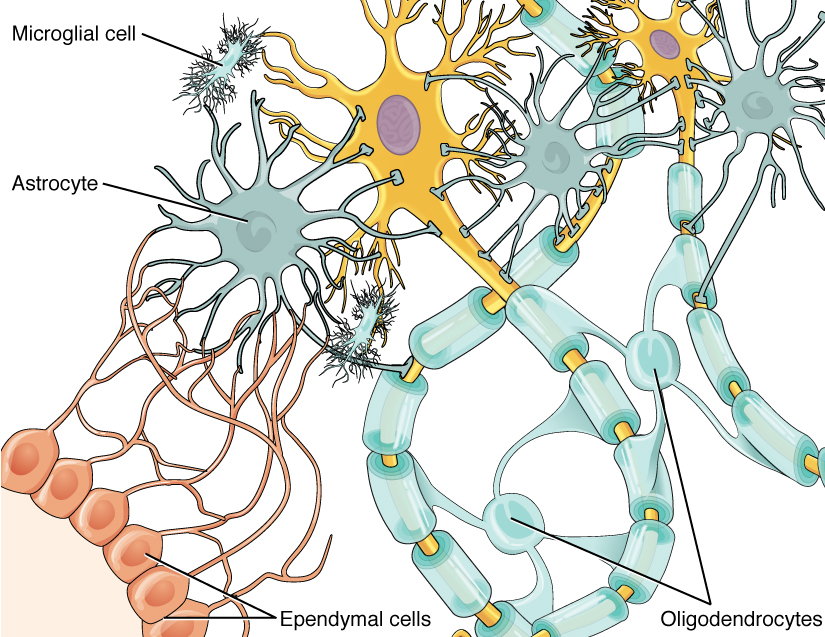
Glial cells! The microglial cells (upper left) are mobile and will wreck you if you go into the brain. CC, 2020
The chemical signals from the microglia will also trigger other glial cells that send the information of a pathogen invasion to the central nervous system itself, kicking off the body’s immune response. Astrocytes – the same cells that help to keep the blood-brain barrier tight, will release signals to the endothelial cells of the blood-brain barrier that loosen the tight junctions, allowing immune cells (macrophages, T Cells and B Cells) to make their way into the brain and central nervous system, something that is usually forbidden to the cells of the immune system.
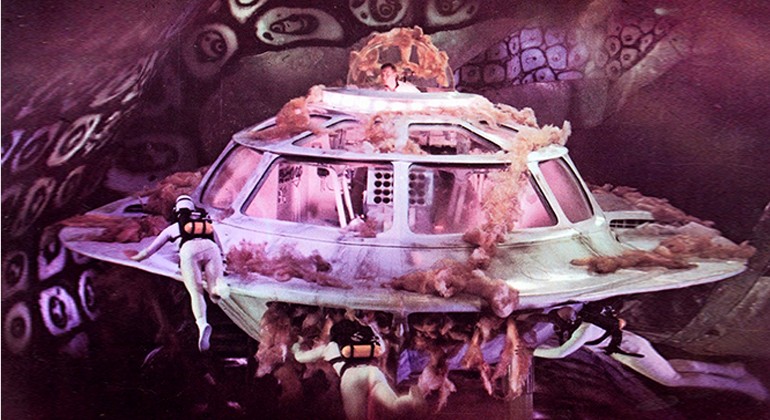
In Fantastic Voyage, the immune system was a constant threat to the Proteus and her crew (c) 20th Century Fox
If the action of the microglia and the cells from the greater immune system that have been given a day pass to help out can’t quickly get rid of the pathogen, the cycle keeps on going – more signaling, more cytokines, more immune cells, more inflammation. More inflammation, more volume being taken up in a container that is inflexible (the skull), resulting in more pressure on the brain and everything in it – including the nerves and blood vessels.
None of this is good.
And that’s the thing you’ve got to remember if you ever end up heading into a brain like the Atom…even if the Atom was completely sterilized and cleaned, would be fighting the immune system of the person he was in from the first minutes of his arrival and if he’s in the brain, then you’ve got neuroinflammation. He’s “the other” in a different body. It’s nothing personal from the immune system. It’s just its job.

His hair exposed, his costume exposed to the plasma…oh he’s a red alert for the immune system. Props for the cholesterol snark though, Atom (c) DC Comics
Story-wise, the immune response is a show-stopper, and it’s understandable why it’s completely left out or minimized to the point of uselessness (“Look! Six macrophages! Pew-pew-pew! We’re safe!”) that would indicate the person has a really suppressed immune system.
You’ve got it working in your body. That’s good. So far, Ray has yet to really face down someone’s immune system. That’s good, too. The story would suck, because Ray would die at the immune system’s assault.
Every time.
Tiny Bull in a Gray China Shop
From the first time Ray Palmer entered a brain, we’ve seen a couple of things – again, DC Universe brains don’t work the same way ours do, and also – Ray is a polymath of the highest order. His Ph.D. may be in physics, but he knows brain function, anatomy, and pathology better than a hospital full of neuroscientists. He’d have to – otherwise, the stories would be pretty tragic. I mean – I’d hate to see the “first” first time Ray attempted to fix someone’s brain…the attempt that didn’t make it into a comic story, where he came out of a dead patient, or a patient who was seizing, or…you get the idea.
Who does the family sue?
That aspect of a small person doing damage in a human brain has been played with more than once. In Injustice 2 #6, following orders from Batman, Ray took down Superman by stabbing him in a part of the brain (probably a portion of the medulla oblongata) with a radioactive kryptonite shard, most likely causing a hemorrhagic stroke…along with possibly destroying a significant portion of the medulla. Ray wasn’t trying to do anything temporary, or something that Superman could heal from (full disclosure – he may have healed from it). Again, comics.
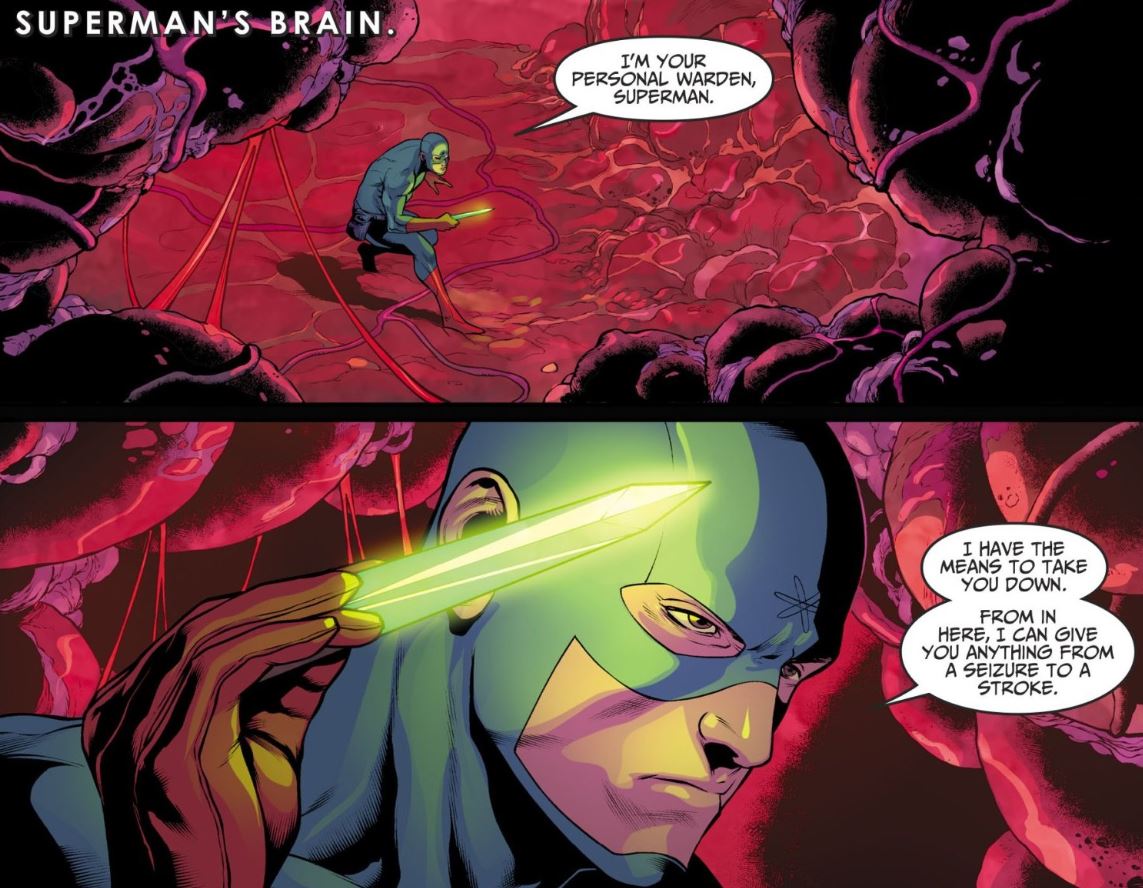
This is like, the Savage Atom…inside Superman’s brain with a radioactive Kryptonite shard. (c) DC Comics
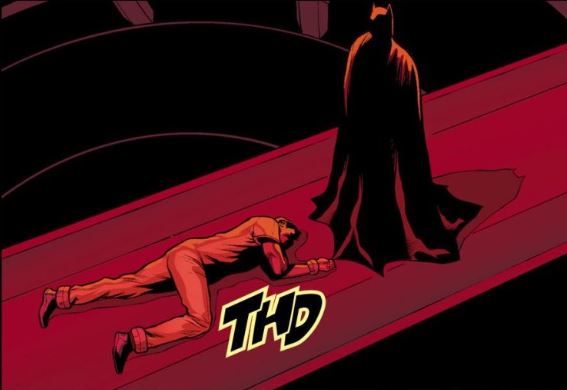
The Atom makes good on his promise. Again – I’m guessing her got better… (c) DC Comics
In Legion of Super-Heroes #294 Shrinking Violet (a legacy character inspired thematically, if not literally by the Atom) got into the brain of one of Darkseid’s servants and blocked off a blood vessel, causing the servant to collapse from the transient ischemic attack (TIA) she caused.
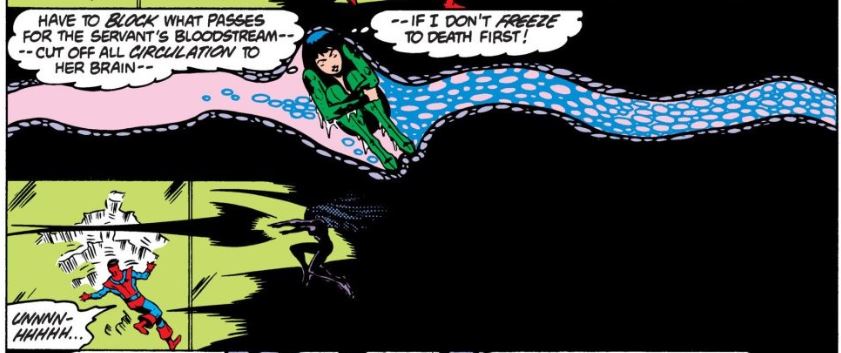
Shrinking Violet causes a Transient Ischemic Attack in one of Darkseid’s servants – harsh… (c) DC Comics
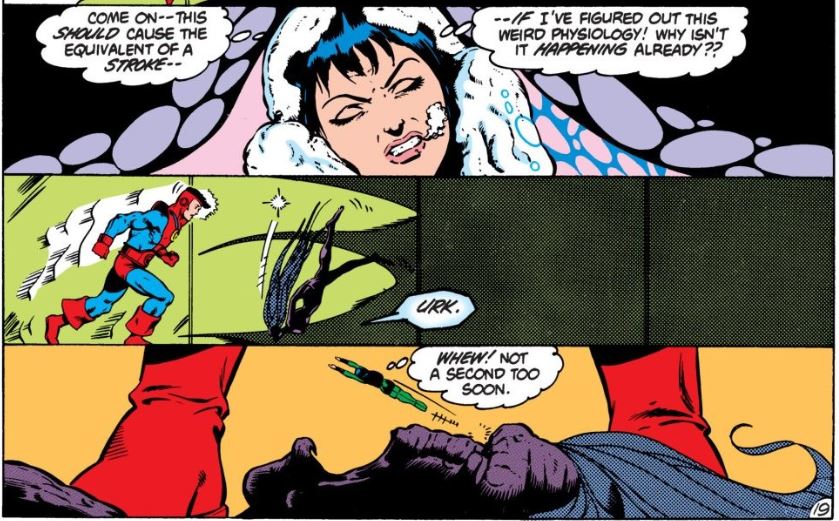
…but effective (c) DC Comics
In JLA #14 Ray – after commenting that Darkseid’s brain had four lobes – shot Darkseid right in the brain with an energy blast to kill him, sacrificing himself in the process (it was an alternate, possible future).
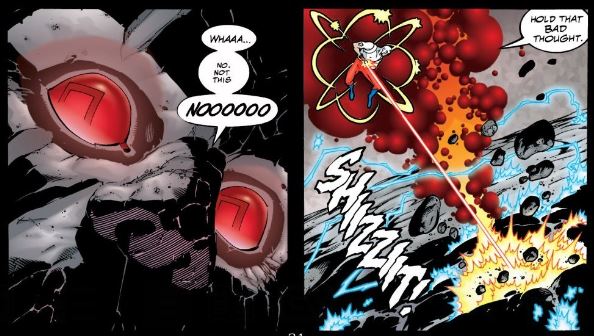
Again, the Savage Atom. (c) DC Comics
And perhaps most infamously, it was revealed in Identity Crisis #7 that Jean Loring, Ray’s on-again, off-again wife “accidentally” killed Sue Dibney when she stole Ray’s suit and went into Sue’s brain. Jean’s story was that she just wanted to give Sue a mild event, but couldn’t control the suit’s mass function and basically stomped on her locus coeruleus in her mid-medulla long enough to block the downstream blood flow, resulting in an infarction (obstruction of the blood supply), which would have resulted in a stroke that killed her.

Yeah – this one was rough. Everyone loved Sue… (c) DC Comics

…it was a tough confession to take from Jean. (c) DC Comics
Even though we’ve been doing brain surgery in one form or another for hundreds, if not thousands of years, it’s only in recent history that we’ve gotten pretty good at it. For the vast history of brain surgery, the best explanation of the results seen afterward could have been “I dunno – I just went in there and messed around a little.”
The fact that Ray has gone in multiple times without more damage than what we’ve seen is a testament to his knowledge of the human brain…and of course, some comic book fictional science.
What Does it All Matter, Anyway?
I’m not worried about small people or experimental shrinking subs going into brains. Not at all. But like other times when pop culture and fiction crossover with science, there’s an opportunity for learning. In this case, it was the brain.
It’s amazing. We have just the barest idea of how it works – the most complex thing in the universe – seriously. 86 or so billion, interconnected neurons that makeup everything about who we are, why we do what we do, what we remember, what we’re going to do – all of that, while keeping our body going in the background, and making sure we always remember important stuff that could save our lives. Okay, save our brains. And that’s not even brushing up against the weirdness of say, dreams, or deja vu, or anything that just doesn’t make sense…is our brain trying to fool us? Protect us? Trick us? Why? Whyyyyy?
I didn’t even have a chance to get into Ray’s being “infected” with the Joker’s memories when he went into that brain, of the “lightning storms” that are often seen in depictions of nerve activity in the brain, or the idea of remotely controlling a body just by stimulating (in Ray’s case by running around and hitting) parts of the brain. There are hints, or at worst, whisps of truths in the stories where those events have shown up in Ray’s adventures, but honestly – the reality is so, so much cooler.
The brain is so much cooler. My brain wants your brain to check it out and learn all about it.
If you dug this article, be sure to head over to The Science Of’s Facebook page and give us a follow. Along with curated science content every day, each of these examples showed up there first with a short explanation of the story and a touch of the science involved!
Just a few further brain resources:
Johns Hopkins: Anatomy of the Brain
American Association of Neurological Surgeons
The Internet Stroke Center: Anatomy of the Brain
The Human Memory: Brain Neurons and Synapses
Youtube: Neuroscientifically Challenged
Youtube: Neuroanatomy Video Lab – Brain Dissection
Youtube: Neuroanatomy Made Ridiculously Simple
Queensland Brain Institute: How Are Memories Formed?
(graphic novel) Science Comics: The Brain – The Ultimate Thinking Machine
Comics referred to in this article include (links will take you to their Comixology page):
Power of the Atom #13
The Brave and the Bold #31
Identity Crisis
The Brave and the Bold #115
Legion of Super-Heroes: The Great Darkness Saga
Injustice 2 #6
JLA: Rock of Ages
Batman/Superman #10
Countdown to Final Crisis #4-#2


